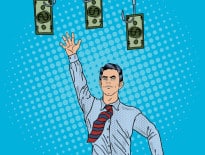We are still a long way from the giddy, greedy and fraudulent days of the real estate bubble circa 2005. But some of the ingredients that came together in such explosive fashion a decade or so ago are swirling around once again. And that can’t be a good thing for anyone worried about a repeat of the real estate market implosion and the Great Recession that followed.
Home prices are hitting new records, forcing would-be buyers once again to stretch to make a purchase, while an increasing number of non-bank lenders are rushing to accommodate them with no-money-down loans, which became popular during the bubble years for similar reasons.
Delinquency rates on mortgages are on the rise again, even as the economic numbers have never looked better in years, which points to problems beyond the ebb and flow of job gains and losses.
And President Donald Trump appears determined to bring back the asleep-at-the-switch approach to federal regulation that helped set the stage for the last real estate bubble, having launched a full-on assault against the Consumer Financial Protection Bureau.
No-money-down loans got a bad rap after the collapse of the real estate bubble. Home prices escalated so rapidly in the mid-2000s that many buyers stretched their finances to the breaking point just to get a foot in the market. Not many buyers were going to be able to come up with a substantial down payment, or even just 2 or 3 percent down, after battling it for the dubious privilege of buying a modest, and ridiculously overpriced, Colonial or raised ranch for $700,000 or $800,000.
Saddled with crushing mortgage payments and with no equity and little savings, many of these new homeowners were especially susceptible when the bottom fell out from the real estate market after its 2005 peak.
In too many cases, it turned out that homeowners with no skin in the game had less incentive to hang on when prices cratered. On top of that, with no equity, they were far more likely to end up underwater, owing more on their mortgages than their homes were worth.
Banks and other lenders, as they typically do, suddenly went full speed in the other direction in the wake of the big slump, becoming ultra-orthodox in their mortgages. Since then, no-money-down loans have made a comeback, slowly at first and mainly underwritten by various federal and state mortgage programs.
But as home prices have kicked into high gear again, there are signs the best of intentions may be taking a back seat as more lenders, particularly non-bank players, jump on the no-money-down bandwagon.

Scott Van Voorhis
The Return of Creative Lending
There has been a marked increase in ads touting no-money down or other creative financing options, Jill Chodorov Kaminsky, a Maryland broker, notes in a recent column for The Washington Post.
“We are at 360 degrees in the cycle,” Chodorov Kaminsky writes.
While no-money-down mortgages may sound cheap, they are anything but, Chodorov Kaminsky notes, pointing to fees tucked into these mortgages and their higher interest rates.
With the return of creative lending, mortgage default rates are on the rise as well. Sure, they are nowhere near the epidemic levels we saw after the collapse of the real estate bubble. But the delinquency rate on one- to four-unit residential properties rose to 5.17 percent of all loans at the end of 2017, up 37 basis points from the same period in 2016, according to the Mortgage Bankers Association. That extends a trend that was already underway by the end of 2016, long before Hurricanes Irma and Harvey hit.
With the economy better than it has been in at least a decade, the rise in defaults is puzzling, to say the least, if not downright worrisome, given the budding comeback of creative mortgage lending.
Of course, the last time around federal and state regulators were nowhere to be found as default rates rose amid a flood of lending abuses.
This time, at least we have the Consumer Financial Protection Bureau, launched in the wake of all the mortgage abuses and various financial scandals that came close to capsizing the world economy back in 2008. But for how long is the question, with the Trump Administration determined to turn the new regulator into a toothless tiger, if not euthanize it altogether. The agency, under Trump lackey Mick Mulvaney, has delayed a new rule aimed at reining in payday lenders and scuttled a case against an online loan shark operator.
We are not yet back to the bad old days of the mid-2000s when mortgage lending went off the rails. But with regulation of all sorts now in full retreat, the ingredients in place for some serious trouble down the line.






